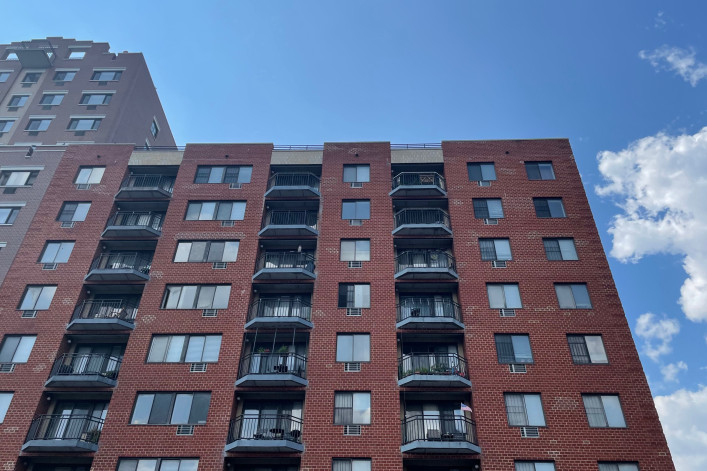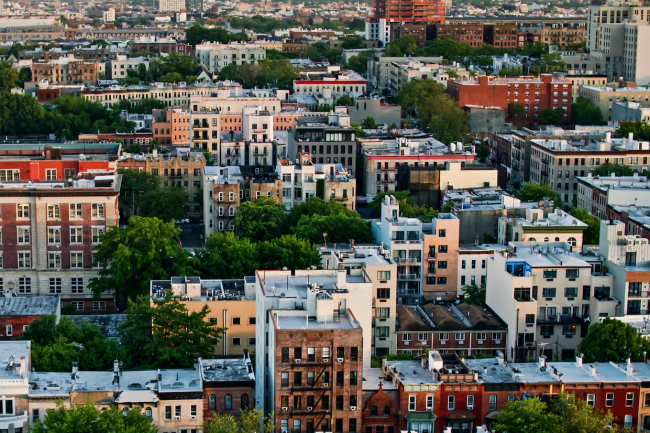What are the pros and cons of living in a top-floor apartment in NYC?

Living on the top floor may offer you more privacy and less noise—but there's potential for leaks and rowdy rooftop parties.
When you’re searching for an apartment in New York City, it’s important to consider where a new place is located—not just the neighborhood, but in the building. The top floor might seem like the best place to be because no one is above you, but there are some downsides to living higher up.
It doesn’t matter if you buy or rent, it can be a pain if you have to deal with a leaking roof—or neighbors’ rowdy rooftop parties.
Still, the top floor is the crown of most buildings, says Vickey Barron, a broker at Compass. She has a client who is looking exclusively at apartments on the top floor for extra privacy and better views, which are appreciated if you work from home.
“Covid has magnified [top-floor apartments] because some people are spending more time at home,” she says.
But it’s not everyone’s preferred place to live. Steven Gottlieb, a broker at Warburg Realty, says that it’s not a frequent request from his clients. Many people prefer living on higher floors but not the top floor because you get most of the benefits without being directly below the roof, he says.
Keep reading for what you should know about living in a top-floor apartment. And if you’re looking to buy a penthouse, here’s our advice.
What are the pros of living in a top-floor apartment?
One of the main draws of top-floor apartments is the extra privacy, Barron says. In smaller, walk-up buildings with only a few apartments on each floor, you will have fewer neighbors passing your apartment. You might even have the floor to yourself, which means even less noise.
Top floor apartments are also quieter because no one lives above you—no footsteps above your head to drive you nuts. If you’re in a high rise, there’s less noise from the elevator passing—and you're farther away from the street—which helps mitigate the sound of traffic and other noise.
Another benefit: Some people feel safer the farther they are from the street—either on the top floor of a six-story walk up or on the 20th floor of a high-rise, Barron says.
Do you prefer a bright apartment? The higher you live, the more sunlight you will get, Gottlieb says. And you will have better views compared to lower floors.
You may also have access to outdoor space—either a private or shared roof deck. And even if it’s shared, you’ll be able to use it most easily since it’s just one flight up.
What are the cons of living in a top-floor apartment?
One of the most important things to consider for both buyers and renters is the cost (or rent) of the apartment. Barron says that buyers typically pay a premium to live on the top floor so expect to pay more than you would for a similar apartment on a lower floor of the same building. Apartment prices on the same line typically increase by 1 percent for each floor you go up, Jonathan Miller, president of real estate appraisal firm Miller Samuel, previously told The New York Times.
If you’re looking to buy in a co-op, units on the top-floor tend to have more shares, especially if they have outdoor space, which translates to higher monthly maintenance costs. For renters, this means if you’re looking to sublet a top-floor co-op, your rent might be higher.
Because your ceiling will be the roof of the building, your apartment is more exposed to the elements. One of the biggest downsides to living on a top floor is the potential for leaks. Buyers should request an inspection to make sure there aren’t any leaks or issues with the roof. For renters, you should ask when the last inspection was and if there have been any major leaks in the last two years, Barron says.
It’s not just exposure to leaks, but also the sun, especially during the summer. Top-floor apartments tend to get hotter so you might have to use the air conditioner more often, and that means higher energy bills.
If there’s a common roof deck above the apartment, you should ask what the hours are and how often the space is used, Barron says. And if you live in a smaller building with an unfinished roof, tenants may still hang out there during the summer.
However, Gottieb says often amenity spaces like roof decks are not used very much.
And finally: Before you move into a top-floor apartment, also ask yourself how much time you want to spend waiting for an elevator, Gottieb says.
Not only will your elevator ride be longer, but you’ll be stuck waiting often. On the flip side, if it’s a walk-up building, you have to consider if you’re willing to use the stairs to get up and down—especially when you have a week’s worth of groceries to carry up with you.
You Might Also Like



























